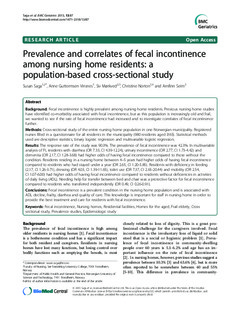| dc.contributor.author | Saga, Susan | |
| dc.contributor.author | Vinsnes, Anne Guttormsen | |
| dc.contributor.author | Mørkved, Siv | |
| dc.contributor.author | Norton, Christine | |
| dc.contributor.author | Seim, Arnfinn | |
| dc.date.accessioned | 2018-02-26T12:16:23Z | |
| dc.date.available | 2018-02-26T12:16:23Z | |
| dc.date.created | 2013-10-16T13:53:53Z | |
| dc.date.issued | 2013 | |
| dc.identifier.citation | BMC Geriatrics. 2013, 13 (87). | nb_NO |
| dc.identifier.issn | 1471-2318 | |
| dc.identifier.uri | http://hdl.handle.net/11250/2486985 | |
| dc.description.abstract | Background
Fecal incontinence is highly prevalent among nursing home residents. Previous nursing home studies have identified co-morbidity associated with fecal incontinence, but as this population is increasingly old and frail, we wanted to see if the rate of fecal incontinence had increased and to investigate correlates of fecal incontinence further.
Methods
Cross-sectional study of the entire nursing home population in one Norwegian municipality. Registered nurses filled in a questionnaire for all residents in the municipality (980 residents aged ≥65). Statistical methods used are descriptive statistics, binary logistic regression and multivariable logistic regression.
Results
The response rate of the study was 90.3%. The prevalence of fecal incontinence was 42.3%. In multivariable analysis of FI, residents with diarrhea (OR 7.33, CI 4.39-12.24), urinary incontinence (OR 2.77, CI 1.73-4.42) and dementia (OR 2.17, CI 1.28-3.68) had higher odds of having fecal incontinence compared to those without the condition. Residents residing in a nursing home between 4–5 years had higher odds of having fecal incontinence compared to residents who had stayed under a year (OR 2.65, CI 1.20-5.85). Residents with deficiency in feeding (2.17, CI 1.26-3.71), dressing (OR 4.03, CI 1.39-11.65), toilet use (OR 7.37, CI 2.65-20.44) and mobility (OR 2.54, CI 1.07-6.00) had higher odds of having fecal incontinence compared to residents without deficiencies in activities of daily living (ADL). Needing help for transfer between bed and chair was a protective factor for fecal incontinence compared to residents who transferred independently (OR 0.49, CI 0.26-0.91).
Conclusions
Fecal incontinence is a prevalent condition in the nursing home population and is associated with ADL decline, frailty, diarrhea and quality of care. This knowledge is important for staff in nursing home in order to provide the best treatment and care for residents with fecal incontinence. | nb_NO |
| dc.language.iso | eng | nb_NO |
| dc.publisher | BioMed Central | nb_NO |
| dc.relation.uri | http://www.biomedcentral.com/content/pdf/1471-2318-13-87.pdf | |
| dc.rights | Navngivelse 4.0 Internasjonal | * |
| dc.rights.uri | http://creativecommons.org/licenses/by/4.0/deed.no | * |
| dc.title | Prevalence and correlates of fecal incontinence among nursing home residents: a population-based cross-sectional study | nb_NO |
| dc.type | Journal article | nb_NO |
| dc.type | Peer reviewed | nb_NO |
| dc.description.version | publishedVersion | nb_NO |
| dc.source.pagenumber | 10 | nb_NO |
| dc.source.volume | 13 | nb_NO |
| dc.source.journal | BMC Geriatrics | nb_NO |
| dc.source.issue | 87 | nb_NO |
| dc.identifier.doi | 10.1186/1471-2318-13-87 | |
| dc.identifier.cristin | 1058202 | |
| dc.description.localcode | © 2013 Saga et al.; licensee BioMed Central Ltd. This is an Open Access article distributed under the terms of the Creative Commons Attribution License (http://creativecommons.org/licenses/by/2.0), which permits unrestricted use, distribution, and reproduction in any medium, provided the original work is properly cited. | nb_NO |
| cristin.unitcode | 194,65,20,0 | |
| cristin.unitname | Institutt for samfunnsmedisin og sykepleie | |
| cristin.ispublished | true | |
| cristin.fulltext | original | |
| cristin.qualitycode | 1 | |

